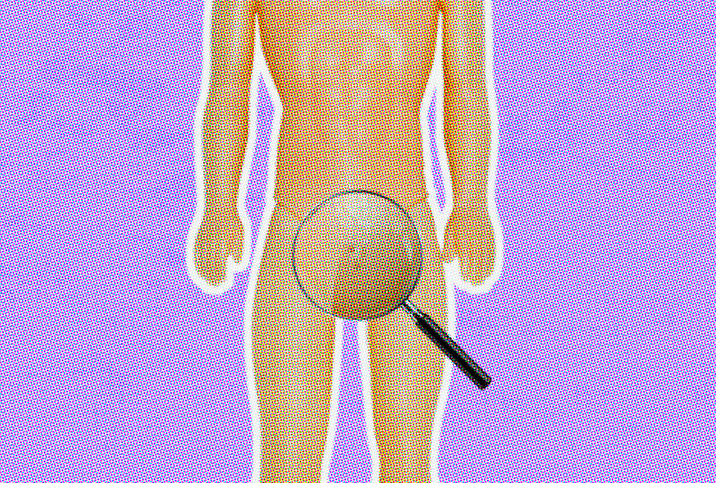How Many of These Penis Conditions Have You Heard Of?

There's a stubborn myth that women's reproductive organs are complicated and men's genitalia is simple. While it's true women face the joys of periods and Pap smears, guys experience a host of complications in their nether regions, too.
One stereotype that's not a myth is male reluctance to seek medical treatment. That's a great way to make any problem with your penis and testicles worse than necessary.
Penis conditions are aplenty, and no matter how up on physiology you think you are, you might not know some of the following ailments. Not all of them are self-inflicted, but they're all exacerbated by not seeing a healthcare professional right away.
Condyloma
Condyloma is another name for genital warts, a type of sexually transmitted infection (STI) that's caused by certain strains of the human papillomavirus (HPV). Many men ignore the odd lump or bump on their penis, but they do so at their peril.
"Condylomas can form all over the genitals," said Amy Pearlman, M.D., a urologist and the director of men's health at the Carver College of Medicine at University of Iowa Health Care. "They can grow out of control and look like essentially cauliflower that covers the entire penis and scrotum."
Condylomas can even spread to the inside of the urethra. When you consider the typical treatment involves lasers or freezing, let's just say it would be better to get rid of them sooner rather than later.
Buried penis
Buried penis is a condition in which the penis shaft is mostly or completely hidden due to ligament abnormalities, surgical complications, swelling or obesity.
While buried penis is more common in infants due to complications with circumcision, the obesity epidemic is leading to more adult men developing buried penis. It occurs when the fat above the penis and testicles accumulates to such a degree that it droops down and effectively hides the genitals.
"You look at them and you don't see anything," Pearlman said. "It's completely buried. I've had guys come in and say, 'I have a small penis' or 'I have a micropenis.' But they're literally covering up inches of their penis with excess suprapubic fat."
It gets worse. Having to urinate out of an enclosed packet of fat in a difficult-to-reach area can lead to complications, starting with an overgrowth of the yeast that proliferates in chronically moist environments.
"So that can cause inflammation, and the tissue can actually scar over the penis and bury everything in," Pearlman said. "For some guys, you can pull their penis out; you can expose the entire thing if you push the fat back. But for other people, because of this chronic inflammation, the tissue will actually scar over the penis where you can't see anything and you can't pull the penis out."
There are surgical fixes of all kinds. They may involve skin grafts on the penis shaft, pulling the penis down and out through a new opening in the scrotum, and possibly the surgical removal of the panniculus, or pannus, the apron of fat that hangs down on morbidly obese people.
But first things first: Getting a patient's weight under control is the top priority—out of necessity.
"We talk about the importance of weight loss, especially if they have a very obese abdomen," Pearlman said. "If when they stand up and we unbury the penis, and they have a very large pannus, it cannot be a successful operation if it's then going to rebury."
Priapism
Jokes aside about how great a four-hour ED-medication-induced boner should be, priapism can be a very real and dangerous problem.
Priapism occurs when the penis remains erect without stimulation or after stimulation has ended, and it's no joking matter.
"We see a lot of priapism," said Neel Parekh, M.D., a urologist whose practice is affiliated with Cleveland Clinic. "We see it pretty often, but never after Viagra or Cialis. It's very unlikely after the pills, even if the commercials make it seem like it happens all the time."
However, Parekh pointed out that priapism is caused fairly frequently by a number of other medications, including a psychiatric med called Trazadone and certain erectile dysfunction treatments that involve injecting medication directly into the penis.
While an erection that lasts for hours may sound like a good time, it doesn't take long for tissue damage to set in.
"The penis starts getting hypoxic after four hours, and you may start getting necrosis in the penis," Parekh said. "So it does need to be addressed sooner rather than later, because after 24 hours, you can suffer permanent ED, and the longer you wait, the more severe the damage is."
Peyronie's disease
Peyronie's disease is a curvature of the penis that may be hereditary but usually happens over time as the penis experiences various micro-traumas that build up plaque as they heal, or after a man "breaks" his penis.
Yes, you can snap the tough elastic sheath that surrounds the erectile tissue—anatomically, this is the tunica albuginea—which usually happens during vigorous sexual activity. At the spot of the break, fibrous scar tissue or plaque builds up, causing the penis to curve, typically during erections.
Many men experience pain with their erections during the acute phase of Peyronie's, the first 12 to 18 months after the break. Worse still, for lots of guys, the resulting curvature can lead to a loss of length.
"When we talk about young men having safe sex, not only do we talk about STIs, but also you have to be careful with your penis," Pearlman said. "You can injure your penis. Especially when it happens to young men, it can be devastating because they can lose length, they can lose girth, their penis looks different, and they don't know what to do about it."
Peyronie's is another condition that belongs on the list of "see a doctor right away" problems. With quick action, treatments such as traction devices, vacuum pumps and injections to break up the plaque are all available to prevent the curve from setting in, or at least reducing its effects.
But the key is getting treated right away.
"The thing about a lot of the conditions we've discussed is, they're not always preventable, but people can minimize their risk if they know about them," Pearlman said. "If you notice something change, go see a healthcare provider, because they can prevent it from getting worse."




















